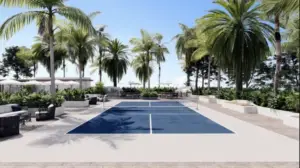Ever find yourself setting up your own area to play and wondering what the official pickleball court dimensions are? You’re not alone. With the sport’s skyrocketing popularity, it can be harder to get playing time at the local courts. Plus with the rise of portable nets, sometimes it’s easier to make your own place to play so you can get to hitting those perfect dinks and dropshots faster.
But getting the size right is an important factor in having a great game — it determines the amount of space players have to move and hit the ball and ensures when you take your talents to the public pickleball courts, your game won’t suffer.
Pickleball Court Dimensions
Official court dimensions for Pickleball
According to USA Pickleball Association (USAPA), the official dimensions of an outdoor pickleball court are a length of 20 feet (6.1 meters) and a width of 44 feet (13.4 meters). This means that the total playing area of a pickleball court is 880 square feet (81.6 square meters).

It is important to note that these dimensions only apply to outdoor courts; indoor courts may have slightly different dimensions due to space constraints.
Indoor pickleball court dimensions
The dimensions of an indoor pickleball court are slightly smaller than those of an outdoor court. They should have a length of 20 feet (6.1 meters) and a width of 34 feet (10.4 meters).
This means that the total playing area of an indoor pickleball court is 680 square feet (63.2 square meters). Note that these dimensions are the minimum size recommended by the USAPA for indoor play. If there is more space, feel free to play on a larger court as long as it doesn’t exceed the outdoor court size.
Pickleball court lines
Beyond the length and width of the court, there are several other markings and lines that are used to define the playing area.
- The non-volley zone line (NVZ line): Also known as the “kitchen” and is located 7 feet (2.13 meters) from the net on both sides of the court. Players are not allowed to hit volleys (balls that are hit before they bounce) within this area.
- The baseline: This is the back line of the court and marks the boundary of the playing area.
- The centerline: This line divides the court in half lengthwise and is used to determine serves and out-of-bounds calls.
How thick are pickleball lines? According to USA Pickleball Association (USAPA), they should be 2 inches and white.

Proper pickleball equipment
In addition to these lines, there are also several other equipment and features that are used on a pickleball court. These include:
- The net: The net is used to divide the court in half and is 3 feet (0.9 meters) high at the center and 3 feet 6 inches (1.07 meters) high at the posts. It is made of nylon or polypropylene and is attached to the posts with ropes or cables. Note that the pickleball net height should be 36 inches on the side and 34 inches in the middle.
- The posts: The posts are used to support the net and are typically made of metal or PVC. They are placed on either side of the court and are attached to the base with bolts or screws.
- The paddles: Pickleball paddles are used to hit the ball and are typically made of composite materials such as graphite or fiberglass. They are smaller and lighter than tennis racquets and have a shorter handle.
- The ball: Pickleball balls are made of plastic and have a hole in the center. They are typically larger and slower than tennis balls and are designed to bounce lower.
Importance of pickleball court size
Is size really that important for a pickleball court? Yes, yes it is.
If it’s too small, it can make the game more challenging and less enjoyable for players. A smaller court means that there is less space for players to move and hit the ball, which can lead to more collisions and errors. It can also make it more difficult for players to execute certain shots and strategies, as there may not be enough room to set up for certain shots or to move into position to defend against them.
On the other hand, if a pickleball court is too large, it can also negatively impact the game. A larger court means that players have more ground to cover, which can be tiring and may lead to a slower pace of play. It can also make it more difficult for players to keep track of the ball and anticipate where it will land, as the ball will have more time to travel and bounce.
Wrap up
Proper pickleball court dimensions provide the right balance of space for players to move while still maintaining an appropriate level of challenge and intensity. If you are playing on a court that doesn’t meet these requirements, it may be worth considering finding a court that is more suitable for play.

Spencer is writer and website owner from California. He started playing pickleball with his pops and they have a running tally of matches won and lost. Spencer declines comment on where the record stands.









5 thoughts on “Pickleball Court Dimensions: Everything You Need to now”
Comments are closed.